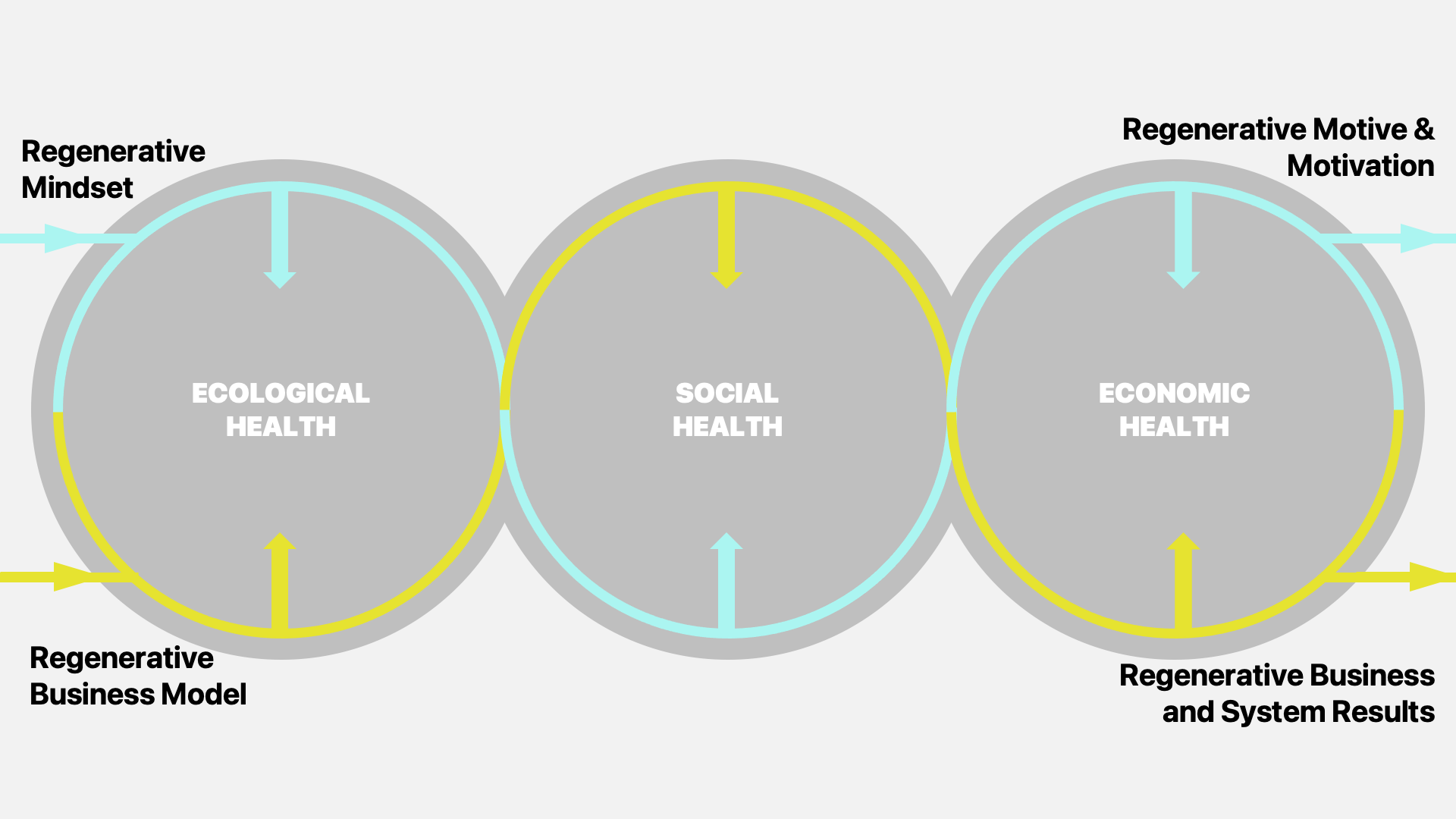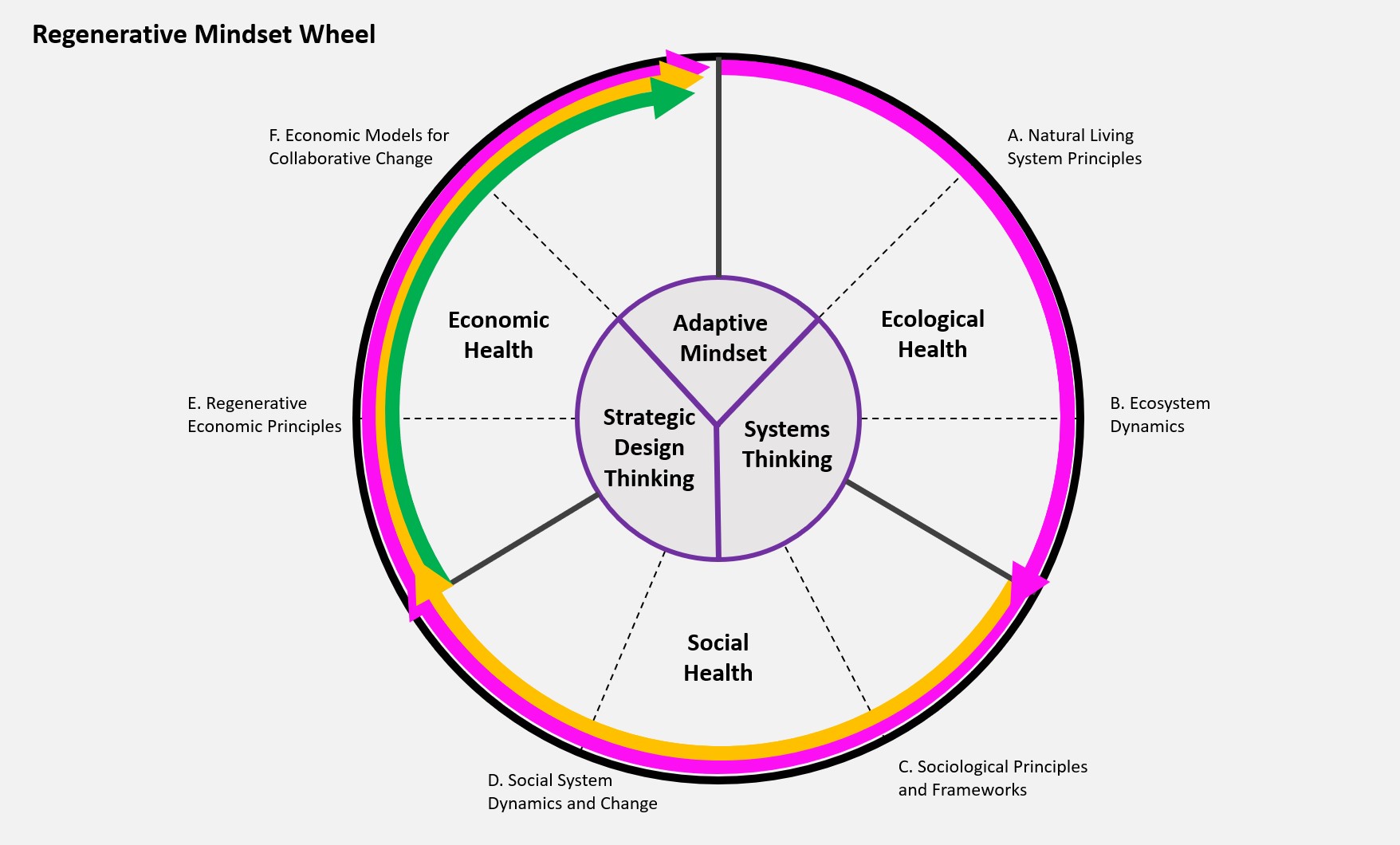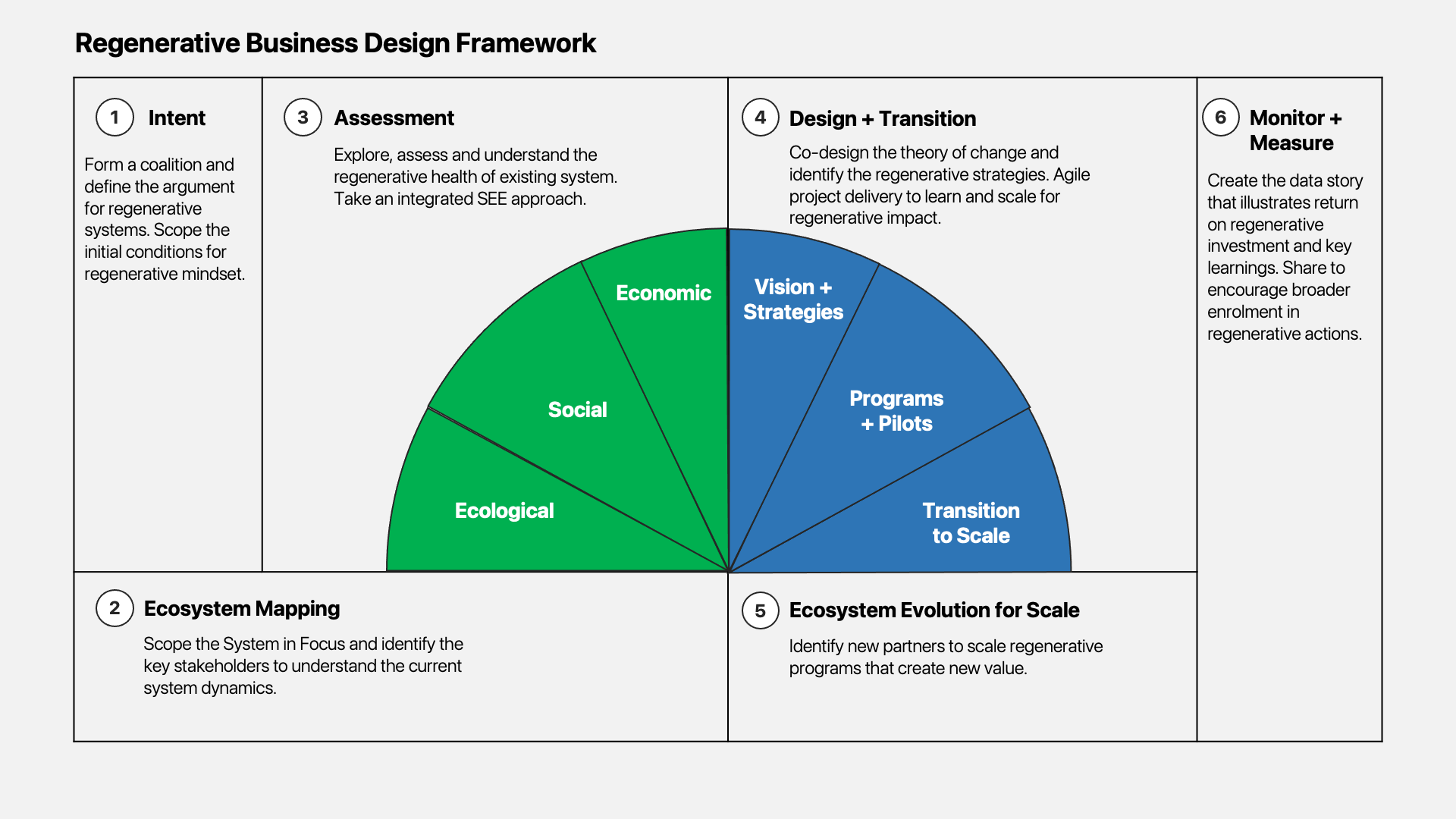Creating regenerative business models is a nuanced process that takes time, effort, and an open-minded approach. At its core, a regenerative business model aims to not only avoid negative impacts but to actively improve the well-being of the environment and society. The task for Boards and Executives is ‘how-to’ shift entire business models, and in this quest, being aware of what to look for, is of critical importance.
What is the current frame?
If you google the question ‘how to create regenerative business models?’ you will find the majority of the information presented is framed and organised to assess an organisation’s business model analytically – analyse your environmental and social impacts. This approach leans towards the analytic and does not immediately consider the mindsets and behaviours that are lateral and creative aspects necessary for turning old-world order business models into sustainable and regenerative businesses. For example, the typical narrative that you may read:
To create a sustainable and regenerative business model, businesses must first focus on identifying and understanding their impact on the environment and society and then work to incorporate regenerative practices that improve natural and social capital. This can include adopting circular economic principles, investing in renewable energy and sustainable manufacturing practices, supporting fair labour practices, and much more.
Then, the additional comment stated, as an assumed element:
Ultimately, a regenerative business model requires a shift in mindset from the traditional “taking” approach to one that is rooted in collaboration, innovation, and care for our planet and communities.
The mindset shift arguably is the most challenging and the most important element as businesses and industries shift toward sustainable and regenerative businesses because the mindset is what lays the foundations for new ideas, rethinking old ways of working that are in harmony with the planet.
What if we took an integrated approach: regenerative mindset and business model analysis?
Leading organisations invest in their people’s regenerative mindset, which drives attitudes, values and behaviours. However, in many cases, organisations choose to invest in technical projects, and invest in technical people, rather than also investing in their people. What is needed is an integrated approach, which embraces mindset change as well as business model change. A model we have developed at the Institute for Regenerative Design is the Ecological, Social and Economic Design model (SEED). This model is inspired by several sources of thinking about regenerative systems (Mang and Reed (2012), Hahn and Tampe (2020)), acknowledging that the shifts towards regenerative systems must be both a mindset and a business model change. These two threads are weaved to understand the conditions of the ecological, social and cultural systems that need to be created, stimulated and managed to achieve regenerative systems.

Model of Ecological, Social, Economic Health Design for Regenerative Systems (adapted by ThinkPlace Institute for Regenerative Design, 2023)
The Regenerative Mindset thread takes a pathway of understanding, building new literacy, and establishing foundations of knowledge that underpin cultures that can take an integrated view to their work, practice and innovation-ability towards regenerative models, services and products.
The Regenerative business models thread takes a pathway of collaboration, analysis, reframing and remodelling business models, that are integrated across ecological, social and economic health. The analysis of the current business models across the three aspects of ecological, social and economic health informs an integrated set of strategies and solutions.
Taking a learning approach to a Regenerative mindset pathway
We can create a regenerative mindset with a learning and application approach. We have developed a Regenerative Mindset Wheel, where we consider the 6 elements as essential to building this mindset. Each of these elements builds foundational knowledge and skills in:
- adaptive mindset fosters a growth-oriented mentality where leaders and teams are encouraged to embrace challenges, persist through setbacks, and see mistakes as opportunities to learn;
- systems thinking is to understand the interconnectedness and interdependence of different parts of a system, and how changes in one area can affect the entire system. It involves looking at the bigger picture, rather than just focusing on individual components. By taking a holistic view, systems thinking enables us to identify complex patterns, relationships, and feedback loops that might have gone unnoticed otherwise. It also encourages us to consider multiple perspectives and to avoid simplistic solutions.
- strategic human-centred design is about creating meaningful, impactful experiences that resonate with users, and communities on a deep, emotional level, while also delivering measurable results that align with the goals of the organisation.
- ecological health involves understanding basic concepts and principles of natural living systems, and ecosystem dynamics. It builds an ability to understand natural systems and how might we think, and empathise about our place in the context of nature.
- sociological health involves understanding sociology principles, and the dynamics and types of social systems to achieve a particular outcome or result. It builds an understanding of how social structures operate and how they shape social behaviour and in regenerative systems the role of social norms and dynamics.
- economic health is about learning new economic models of value, such as de-growth, collaborative advantage and regenerative economics. Understanding how organisations can contribute to a regenerative economy, means moving away from extractive business models and practices to positive contributions to society and nature.
Importantly the element order is deliberately leaving economic models to the last part, drawing through all previous elements because the pendulum needs to shift hard to a new symbiotic relationship with nature and broader social systems if we have any hope of becoming regenerative systems.

Regenerative Mindset Wheel (developed by ThinkPlace Institute for Regenerative Design, 2023)
Take a collaborative eco-system approach to regenerative business models
As global populations, consumption levels and climate change continue to increase, businesses are increasingly looking at ways to develop more sustainable practices to ensure their long-term success. Achieving sustainability requires a shift from traditional business models that focus purely on maximising profits to ones that prioritise the environmental, economic and social impact of their operations. A key part of this shift is much stronger network models of collaboration and partnerships. The attention to collaborations is at the centre of the Institute’s approach because activities within the control of an organisation, such as those defined as scope 1 and 2 GHG emissions, many strategies are underway but scope 3, indirect, and broader considerations such as social and ecological need a much broader integrated and diverse set of people to come together. The approach we take to (re)design business models involves a clear sequence of activities, which run parallel to the investment in the regenerative mindset. The Regenerative business design model is a 6 stage process:
- Define the Intent: This is forming a coalition and mapping out the argument why changes need to occur, and what a regenerative future means to the collective group. Explore the initial mindset conditions that need to be invested to enable a journey to become regenerative,
- Map the eco-system: This involves a discussion on the scope of the task. and whether you use a scope 1,2 or 3 framework, or another systems model. The important outcome is to identify who is important to engage and collaborate with throughout the process. The mapping is an iterative process and can expect to model this continuously through the process.
- Assess the ecosystem for regenerative health: This assessment explores the system in action and seeks to understand the flows of energy, resources, people, and knowledge. Explore the extent of circular flows, and closed loops; energy flows and carbonisation, fair, equitable labour flows, learning and adapting; value creation; flow of finances etc.
- Design and transition: On the basis of the assessment, co-design the vision for the change that is desired, mapping a theory of change, with strategies that create regenerative actions from regenerative flows, beneficial relationships, balancing system efficiency and redundancy, intervening at differentiated scales, and so on. The design is translated to programs and pilots, which take adaptive and learning approaches, seeking out those projects that can scale. The transition involves changes that include new behaviours, and new practices, both within and across the eco-system. This will require rapid feedback loops and tools to enable and support changes.
- Map eco-system for scale: Mapping out new networks for scaling regenerative projects is a critically important stage, and happens in parallel to stage 4. This stage invites new partnerships and collaborations that create new value.
- Monitor and measure: This is the data story we tell to show our progress and our learnings. This is not just a compliance activity, it is a powerful and important basis to show the return on regenerative investment. The measurement informs storytelling which encourages others to enrol and take up regenerative practices.

Regenerative business design framework (developed by ThinkPlace Institute for Regenerative Design, 2023)
The regenerative business design framework provides a comprehensive approach to sustainability that goes beyond traditional profit-maximising models. By engaging in collaboration and partnerships, organisations can create more holistic solutions for their operations with an emphasis on environmental, economic, and social impact. Through the six stages of this process—Define Intent, Map Ecosystems, Assess Regenerative Health, Design & Transition Strategies, Map for Scale and Monitor & Measure Progress—you can make sure your organisation is not just sustainable but positively contributing to the ecosystem it operates in. With these strategies as part of your organisational ethos, you’ll be able to see real change occur while also ensuring long-term success.
